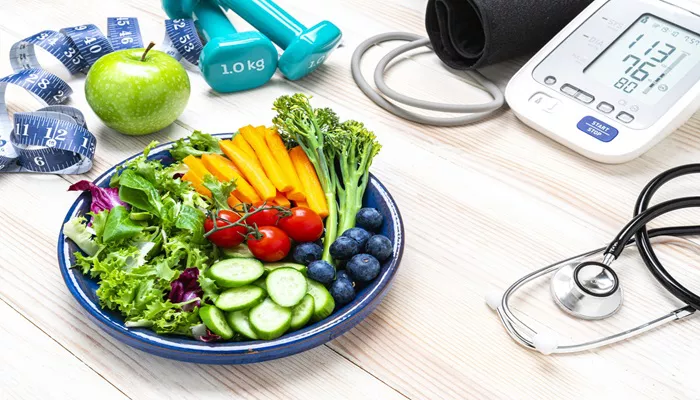High blood pressure, or hypertension, is a significant risk factor for cardiovascular diseases, including heart attack, stroke, and heart failure. Traditionally, managing hypertension often involves medication; however, lifestyle changes can play a crucial role in controlling blood pressure without pharmaceuticals. This article explores practical, evidence-based methods to lower blood pressure naturally, focusing on diet, exercise, stress management, and other lifestyle modifications.
Understanding Blood Pressure
Blood pressure is the force of blood against the walls of the arteries. It’s measured in millimeters of mercury (mmHg) and is presented as two numbers: systolic (the pressure when the heart beats) and diastolic (the pressure when the heart rests between beats). Normal blood pressure is typically around 120/80 mmHg. Hypertension is diagnosed when blood pressure consistently exceeds 140/90 mmHg.
1. Dietary Changes
Adopt a Heart-Healthy Diet
Eating a balanced diet rich in fruits, vegetables, whole grains, lean proteins, and low-fat dairy can help manage blood pressure. The Dietary Approaches to Stop Hypertension (DASH) diet is particularly beneficial. It emphasizes:
Fruits and Vegetables: Aim for at least 5 servings of fruits and vegetables daily. These foods are high in potassium, which helps balance sodium levels in the body.
Whole Grains: Incorporate whole grains such as oats, brown rice, and whole wheat bread. They are high in fiber, which can aid in blood pressure management.
Lean Proteins: Choose lean sources of protein like chicken, fish, and legumes. Reducing intake of red meat and processed meats can also be beneficial.
Low-Fat Dairy: Opt for low-fat or fat-free dairy products to limit saturated fat intake.
SEE ALSO: How Does Angiotensin II Affect Blood Pressure?
Reduce Sodium Intake
Excess sodium can increase blood pressure by causing the body to retain fluid. To lower sodium intake:
Read Nutrition Labels: Check for sodium content in packaged foods. Aim for less than 2,300 mg of sodium per day, or ideally 1,500 mg if you have high blood pressure.
Cook at Home: Preparing meals at home allows you to control the amount of salt used. Use herbs and spices for flavor instead of salt.
Limit Processed Foods: Processed and restaurant foods often contain high levels of sodium. Avoid or limit these foods whenever possible.
Increase Potassium and Magnesium Intake
Potassium helps to balance sodium levels and relax blood vessel walls, while magnesium plays a role in regulating blood pressure. Foods rich in potassium and magnesium include:
Potassium-Rich Foods: Bananas, oranges, potatoes, spinach, and avocados.
Magnesium-Rich Foods: Nuts, seeds, whole grains, and leafy green vegetables.
2. Regular Physical Activity
Engage in Aerobic Exercise
Regular physical activity is one of the most effective ways to lower blood pressure. Aim for at least 150 minutes of moderate-intensity aerobic exercise per week. Activities to consider include:
Walking: Brisk walking for 30 minutes a day can significantly lower blood pressure.
Cycling: Riding a bicycle or stationary bike is another effective exercise.
Swimming: Swimming offers a full-body workout that can improve cardiovascular health.
Incorporate Strength Training
Strength training exercises, such as weightlifting or body-weight exercises, help build muscle mass, which can enhance your metabolic rate and support blood pressure control. Aim to include strength training exercises at least twice a week.
3. Stress Management
Practice Relaxation Techniques
Chronic stress can contribute to high blood pressure. Incorporating relaxation techniques into your daily routine can help manage stress levels:
Deep Breathing Exercises: Practice deep breathing techniques to calm the mind and body. Techniques such as diaphragmatic breathing can help lower stress and reduce blood pressure.
Progressive Muscle Relaxation: This involves tensing and then relaxing different muscle groups to reduce physical tension and stress.
Meditation and Mindfulness: Regular meditation and mindfulness practices can help manage stress and improve overall well-being.
Get Adequate Sleep
Quality sleep is essential for maintaining a healthy blood pressure. Aim for 7-9 hours of sleep per night. Poor sleep or sleep disorders like sleep apnea can negatively affect blood pressure. Establish a regular sleep schedule and create a restful sleep environment.
4. Weight Management
Maintain a Healthy Weight
Being overweight or obese can increase the risk of developing high blood pressure. Losing even a modest amount of weight can have a significant impact on blood pressure levels. To manage weight:
Follow a Balanced Diet: Combine dietary changes with portion control to achieve and maintain a healthy weight.
Increase Physical Activity: Regular exercise helps burn calories and support weight management.
5. Limit Alcohol And Quit Smoking
Reduce Alcohol Consumption
Excessive alcohol intake can raise blood pressure. To lower blood pressure, limit alcohol consumption to moderate levels:
Moderate Drinking: For women, this means up to one drink per day; for men, up to two drinks per day.
Quit Smoking
Smoking damages blood vessels and increases the risk of high blood pressure. Quitting smoking is crucial for overall cardiovascular health and blood pressure management. Seek support if needed, such as counseling or smoking cessation programs.
6. Monitor Your Blood Pressure Regularly
Track Your Progress
Regular monitoring of blood pressure can help track progress and adjust lifestyle changes as needed. Use a home blood pressure monitor to keep track of your readings and consult with a healthcare provider for guidance.
Conclusion
Lowering blood pressure without medication involves a combination of dietary changes, regular physical activity, stress management, weight control, and lifestyle modifications. While these strategies can be effective for many people, it’s essential to work with a healthcare provider to tailor a plan that suits your individual needs. By adopting these natural approaches, you can take control of your blood pressure and improve your overall cardiovascular health.


